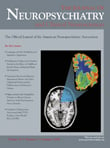To the Editor: We report a case of reversible hyperammonemic encephalopathy induced by valproate in a patient with bipolar disorder whose cognitive abilities remained stable before and after an acute episode as documented by formal neuropsychological assessment.
Case Report
Ms. X was a 41-year-old female patient. Her medical history included a cold thyroid nodule. She had been previously treated for a manic episode with psychotic symptoms with olanzapine, 10 mg p.o., later supplemented by valproate, 1,000 mg p.o., tolerated without major side effects. The patient had discontinued both medications shortly after discharge.
One year later, Ms. X was admitted again for a manic episode with psychotic symptoms. Her previous medications, 10 mg of olanzapine and 1,000 mg p.o. of valproate, were resumed. The following day, Ms. X became drowsy and agitated, walking around restlessly with her eyes closed. On day 3 she became disoriented in time and space and had difficulties standing erect. Neuroleptic malignant syndrome was suspected, but the vital signs were normal, as were laboratory results. On day 6, the blood level of valproate was 131 μg/liter, slightly higher than the recommended value of 125 μg/liter; therefore valproate was decreased. Diagnosis of valproate-induced hyperammonemic encephalopathy was suspected. At 15:15, ammonia level was elevated only at 61 μmol/liter (normal range=9–59), but at 23:20 it returned to normal limits at 34 μmol/liter. Ammonia repeated on day 8 showed elevated levels of 85 μmol/liter at 8:00, and 68 μmol/liter at 13:30. Neurological examination revealed ataxia with adiadochokinesia along with asterixis. An EEG showed symmetric slowing with mild diffuse disturbances.
Valproate was discontinued. The patient improved clinically afterward with a major amelioration in consciousness. Ammonia continued to decrease and had returned to normal limits at 27 μmol/liter by day 10. Two days later, Ms. X was fully oriented but exhibited rebound symptoms of mania. Olanzapine was increased to 15 mg/day. Ammonia levels remained within normal values. The patient made a complete recovery from valproate-induced hyperammonemic encephalopathy but experienced retrograde amnesia for the episode. She was discharged on a regimen of lithium and olanzapine.
Neuropsychological Test Findings
Ms. X had undergone a psychological evaluation 7 years prior to valproate-induced hyperammonemic encephalopathy for vocational counseling. Her global intelligence was average but short-term memory was diminished on account of variable attention and concentration. These premorbid measures served as a baseline for comparison in the neuropsychological assessment conducted 1 month and 1 year postvalproate-induced hyperammonemic encephalopathy.
One month after the valproate-induced hyperammonemic encephalopathy, variable effort and refusal to perform selective tasks characterized the neurobehavioral presentation. The test profile depicted a mild decline in abilities involving verbal abstraction, perceptual organization and construction, and short-term memory, as well as a more severe deterioration in psychomotor speed. Cognitive deficits were also observed in complex learning and executive functions.
One year later, Ms. X was readmitted to psychiatry and again referred for neuropsychological testing. She was more cooperative and motivated to perform to the best of her abilities. The test findings revealed a return to her prior baseline for verbal abstraction, perceptual organization and construction, and short-term memory. As noted previously, the latter fell below expectation relative to her overall intelligence. Only psychomotor speed remained slow and below prior baseline. While complex learning and retention were still diminished, her rate of learning and amount of encoding had improved to some degree. She displayed persisting deficits with spontaneous delayed recall but recognition was perfect, primarily reflecting a retrieval difficulty. Executive functions remained deficient.
In conclusion, the neuropsychological data provided objective and corroborating support for her functional difficulties in everyday living, which is typical for this psychiatric population, while showing a return to prior baseline when comparing her follow-up scores to those of tests administered several years before the valproate-induced hyperammonemic encephalopathy.
Discussion
All 14 published cases of valproate-induced hyperammonemic encephalopathy in the psychiatric setting had a favorable outcome with a return to baseline functioning based upon gross clinical examination.
1 None of these case studies contained detailed neuropsychological testing; one reported the presence of a retrograde amnesia for the event.
2 while another documented changes in Mini-Mental State Examination score from impaired (16/30) in the acute phase to normal (29/30) 1 month later.
3In our case report, the stability of the neuropsychological test results before and after the valproate-induced hyperammonemic encephalopathy argues for a complete recovery of higher mental functions. Regarding Ms. X’s short-term memory or attentional capacities, the premorbid baseline data confirmed that they were suboptimal many years prior to valproate-induced hyperammonemic encephalopathy, and therefore appears unrelated to valproate-induced hyperammonemic encephalopathy.

